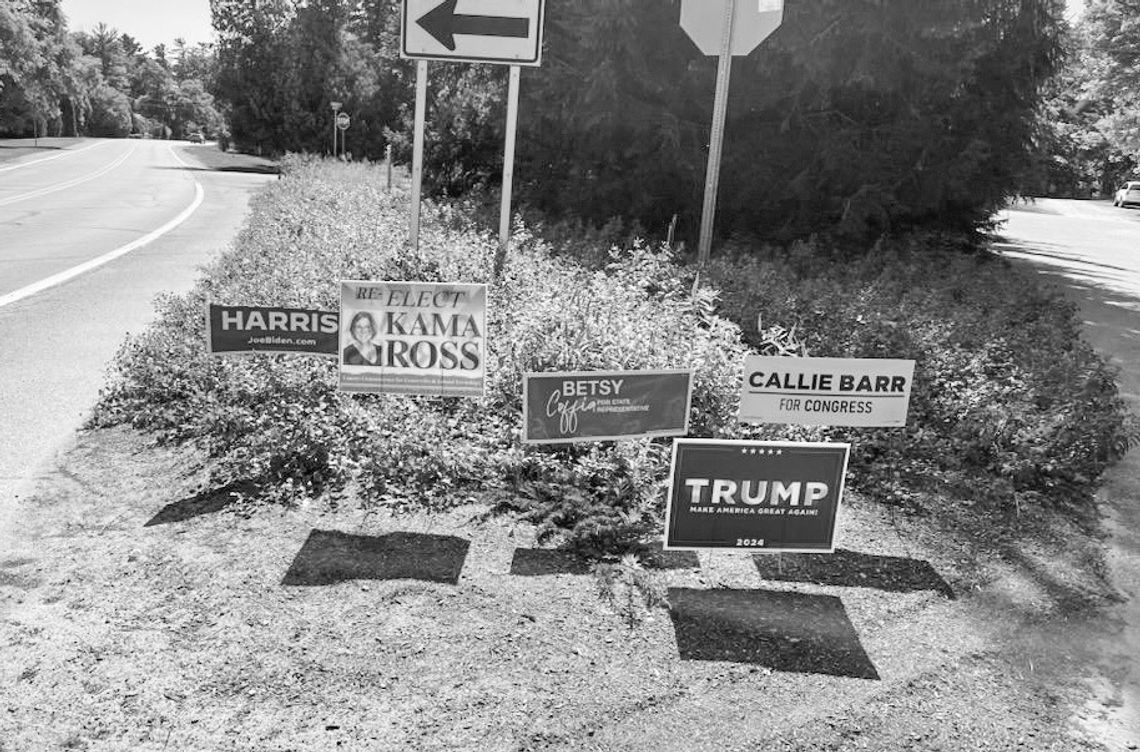A core founding principle of the U.S. is freedom of speech. But free speech doesn’t mean unlimited speech. Supreme Court Justice Oliver Wendell Holmes Jr. used his “shouting ‘fire’ in a crowded theater” analogy to say that some speech isn’t protected by the First Amendment because it could cause panic, injuries, and violence.
Public safety is also the main consideration behind rules on where people can place political signs, Michigan Department of Transportation (MDOT) Communications Specialist James Lake said. Improperly placed signs could prevent drivers from seeing around the corner while trying to merge into traffic.
“We understand peoples’ desire to post their political views, but we want that to be done in a safe way,” Lake told the newspaper. “We’re not looking to target anyone or any candidate. Regardless of the subject of a sign, we need to make sure they’re placed safely.”
MDOT is responsible for correcting sign placement on stateowned roads and highways like M-22, M-72, and M-204, as well as interstate highways and U.S. routes. The Leelanau County Road Commission enforces their own rules on primary roads — which include ones with a CR prefix — and local roads in the townships and villages.
On roads under MDOT jurisdiction, signs must be more than 30 feet from the edge of the highway when there are no barrier- type curbs. MDOT considers the white line on the outside of the road the “edge.” For highways with barrier curbs, the signs must be more than three feet from the back of the curb.
Since MDOT wants to ensure that drivers have a clear field of vision, signs are not permitted at intersections, commercial driveways, freeways, ramps, and limited access rights of way. Political candidates must also get approval from adjacent property owners before placing between properties and state roads.
“After an election, littering is the primary concern,” Lake said. “You must have your signs removed within 10 days after an election.”
This means that all political signs on state roads must be taken down by Nov. 15. MDOT crews will remove any illegally placed signs. They will keep any signs removed in Leelanau County for seven days at their Traverse City office before discarding them.
If a county resident places a political sign on a state road and finds it missing, it could be because they failed to follow the rules. Lake says community members can contact the MDOT office in Traverse City to find out whether staff removed their sign.
The road commission has their own policies that say that no signs — political or otherwise — can be in the right of way on local roads. Road Commission Manager Brendan Mullane said that for the most part, signs must be outside of the right-of-way, which is usually 33 feet away from the center line, depending on the dynamics of the intersection. Moreover, people need to either own the adjacent property themselves or get permission from the owner.
“For enforcement, we’ve upped our efforts in the last couple weeks,” Mullane said Friday. “I have a collection of signs in my office. Our policy says to keep them for two weeks. The people who placed signs can call if their sign was removed.”
“All public roads reside within a public right of way. That public right of way is what we’re here to enforce and protect. It includes room for ditches and everything else. A lot of people believe the road ends at the pavement, but it can be 20 feet away from the white line,” Mullane explained.
Before confiscating the signs, however, the road commission will move them off the road and place a yellow sticker on them. But if the same signs creep back forward into the right of way, they’ll be removed and Mullane will keep them in the road commission garage in Suttons Bay.
One of the first signs that Mullane personally removed was on the corner of M-204 and Lake Leelanau Drive before the state primaries. Known to at least some local Republicans as “the patriot corner,” this area is filled with political signs. Mullane said the signs are now in compliance at 50 feet away.
Mullane said that in addition to clearing vision obstructions, keeping signs off the right of way also allows pedestrians to walk on the side of the road and lets maintenance crews mow the grass on public property.
Mullane added that individual municipalities may have their own ordinances limiting the size of signs. Contact the corresponding township or village for information on any such rules.
If readers see political signs in rights of way or after the Nov. 15 cutoff date, they can contact the Leelanau County Sheriff’s Office, the road commission at 231-271-3993, or MDOT at 517-241-2400.








